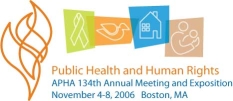 Back to Annual Meeting
|

|
 Back to Annual Meeting
|
APHA Scientific Session and Event Listing |
 Back to Annual Meeting
|

|
 Back to Annual Meeting
|
APHA Scientific Session and Event Listing |
Tracy Wendling, MPH, Injury Prevention Service, Oklahoma State Department of Health, 1000 N.E. 10th Street, Oklahoma City, OK 73117, Shelli Stephens-Stidham, MPA, Injury Prevention Service, Oklahoma Department of Health, 1000 N.E. 10th Street, Oklahoma City, OK 73117-1299, 405-271-3430, shellis@health.ok.gov, and Miriam McGaugh, MS, Community Development Service, Oklahoma State Department of Health, 1000 N.E. 10th Street, Oklahoma City, OK 73117.
Purpose: The purpose of this study was to determine the statewide, population-based incidence and epidemiology of burn and smoke inhalation injuries due to cigarette-related residential fires in Oklahoma.
Methods: Burns and smoke inhalation injuries resulting in hospitalization or death are reportable conditions in the state. Data were abstracted from medical records at burn centers and Medical Examiner reports, and then supplemented with information from the State Fire Marshal, local fire departments, and newspaper clippings.
Results: During the 16-year study period, 272 burn injuries were identified that resulted from cigarette-related residential fires (average annual rate 0.51 injuries per 100,000 population); 76% were fatal. Males were over two times more likely to be injured. Seventy-seven percent of injuries occurred among persons 35 years of age or older; persons aged 75 years and older had the highest rate of injury (1.0 injuries per 100,000 population). African Americans had a rate of injury 64-134% higher than other racial groups. There was a 72% decrease in injuries during the study period (chi-square for trend p<0.00001).
Conclusions: Lighted tobacco products are the leading cause of fire deaths in the United States and cigarettes are the second leading cause of all residential fires in Oklahoma. Despite a decline in injuries, multifaceted prevention strategies are still needed that combine technological, legislative, and educational approaches. The implementation of a fire-safe cigarette law may likely be the next step in preventing these types of injuries.
Learning Objectives: At the conclusion of the session, the participant (learner) in this session will be able to
Presenting author's disclosure statement:
Not Answered
Handout (.pdf format, 35.9 kb)
The 134th Annual Meeting & Exposition (November 4-8, 2006) of APHA